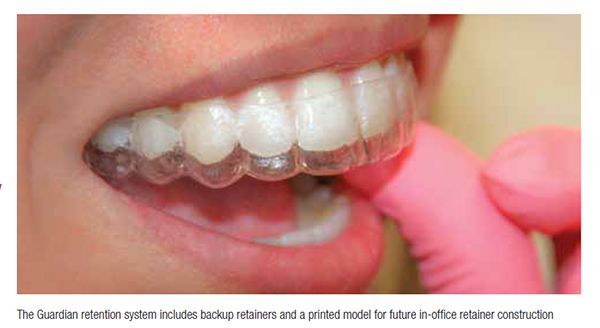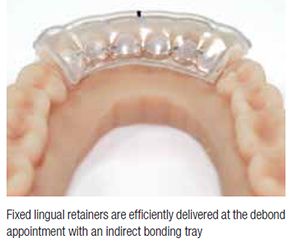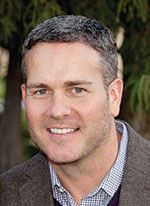James Bonham discusses developments in retainer technology
A good orthodontic retention plan is crucial for every successful practice. Patients not only expect great results from their orthodontic treatment, but also expect those results to last a lifetime. An orthodontist’s ability to meet these high expectations depends on a solid long-term retention plan.
 There is no such thing as a perfect retention appliance. In theory, a fixed lingual retainer is the best answer to maintain long-term tooth position, but many orthodontists consider them a potential hygiene threat. For this reason, most doctors choose removable retainers such as Hawley or clear plastic vacuum-formed retainers. They work great but often fail in the long run due to poor patient compliance. Removable retainers are often lost or damaged. Replacing them usually requires a visit to the orthodontist for new impressions. Patients are always at risk of their teeth shifting if time passes without a retainer. Backup retainers would be ideal, but traditionally, they are not cost-effective.
There is no such thing as a perfect retention appliance. In theory, a fixed lingual retainer is the best answer to maintain long-term tooth position, but many orthodontists consider them a potential hygiene threat. For this reason, most doctors choose removable retainers such as Hawley or clear plastic vacuum-formed retainers. They work great but often fail in the long run due to poor patient compliance. Removable retainers are often lost or damaged. Replacing them usually requires a visit to the orthodontist for new impressions. Patients are always at risk of their teeth shifting if time passes without a retainer. Backup retainers would be ideal, but traditionally, they are not cost-effective.
Recent technologies such as digital impressions and 3D printing have influenced new developments for retention appliances. Specialty Appliances’ laboratory uses this technology to give orthodontists improved options for long-term retention success. All appliances made from the digital process, including fixed lingual retainers (FLR) and clear plastic retainers, are more accurate compared to the traditional impression and stone-model construction process. The digital process can also eliminate the patient’s time without a retainer. Orthodontists have the option of scanning for impressions one appointment before braces are removed. Specialty will digitally remove the braces and construct the initial retainers to be delivered at the debond appointment. Plastic 3D printed construction models are more durable than stone, so multiple backup appliances can be made from a single construction model.
Fixed lingual retainers (FLR)
 Many orthodontists make their own FLR and deliver it at the debond appointment. This in-office process can be time-consuming. Staff members often get frustrated working with wire, dental floss, and low viscosity adhesive to deliver a FLR. Specialty Appliances offers an easy and affordable alternative. As mentioned previously, orthodontists can capture a digital impression and have Specialty make the FLR prior to the debonding appointment. Practices will receive the pre-constructed lingual retainer embedded in an indirect delivery tray. Staff members simply prepare the lingual tooth surfaces, add a small bead of flowable composite to the custom tooth-shaped pads, and then light cure the seated indirect tray. If doctors also prescribe a clear retainer for the same arch, Specialty manufactures a clear vacuum-formed retainer that fits over the FLR. Specialty Appliances reports that 25% of its clear retainers are ordered with an integrated FLR.
Many orthodontists make their own FLR and deliver it at the debond appointment. This in-office process can be time-consuming. Staff members often get frustrated working with wire, dental floss, and low viscosity adhesive to deliver a FLR. Specialty Appliances offers an easy and affordable alternative. As mentioned previously, orthodontists can capture a digital impression and have Specialty make the FLR prior to the debonding appointment. Practices will receive the pre-constructed lingual retainer embedded in an indirect delivery tray. Staff members simply prepare the lingual tooth surfaces, add a small bead of flowable composite to the custom tooth-shaped pads, and then light cure the seated indirect tray. If doctors also prescribe a clear retainer for the same arch, Specialty manufactures a clear vacuum-formed retainer that fits over the FLR. Specialty Appliances reports that 25% of its clear retainers are ordered with an integrated FLR.
Guardian™ invisible retainers
The best way to prevent orthodontic relapse is to provide backup retainers. The Guardian retention system includes multiple clear retainers and a 3D-printed plastic model. Patients now have backup retainers for when they lose or break the original. This sturdy plastic model can be used for the construction of multiple future retainers. Most orthodontists own the proper equipment for in-office construction of vacuum-formed retainers. Patients simply drop off their plastic model when they transition to their backup retainer. Backup retainers do not require a costly appointment for new impressions. The Guardian retention system proactively eliminates a patient’s time without a retainer.
Guardian retainers are also very cost-effective. The original set, including two retainers and the printed model, is about the same cost as a Hawley retainer. Making future retainers from the plastic model is also a great source of revenue for orthodontic practices. Participating orthodontists will charge as little as $50 for backup Guardian retainers. Patients save money, and orthodontists have healthy profit margins making backup retainers without taking up precious chair time.
Stay Relevant With Orthodontic Practice US
Join our email list for CE courses and webinars, articles and mores

 James Bonham is a partner at Specialty Appliances and manages sales and marketing. He has spent the past 12 years in orthodontics with a strong focus on the integration of digital technology into orthodontic practices.
James Bonham is a partner at Specialty Appliances and manages sales and marketing. He has spent the past 12 years in orthodontics with a strong focus on the integration of digital technology into orthodontic practices.
